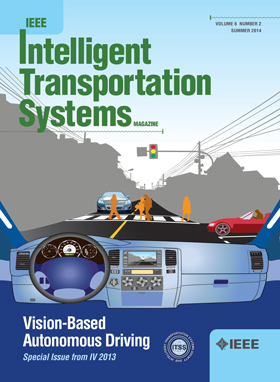具有无碰撞特征的自动驾驶汽车非保守鲁棒路径跟踪控制:一种子多面体集成方法
IF 8.4
1区 工程技术
Q1 ENGINEERING, CIVIL
IEEE Transactions on Intelligent Transportation Systems
Pub Date : 2025-04-16
DOI:10.1109/TITS.2025.3554157
引用次数: 0
摘要
针对大范围时变纵向速度自动驾驶汽车路径跟踪控制设计中的保守性问题,提出了一种具有固有无碰撞过渡特性的子多面体集成方法(sPIA)。该方法将与纵向速度相关的相互依赖的时变参数封装为一组通过连接点相互连接的有限顶点子多面体,从而降低了建模过界引起的保守性。结点的整合和子区域激活规则的制定为避免反馈增益的突变提供了理论基础,保证了子区域之间的无颠簸过渡。设计了增益调度状态反馈控制器,采用参数相关李雅普诺夫函数进一步衰减设计保守性。通过对各种子多面体集成方案的最优${\mathcal {H}}_{\infty }$性能指标的比较分析,证明了该方法在降低设计保守性方面的有效性。此外,利用高保真CarSim-Simulink平台,通过对真实驾驶场景的仿真验证了该方法的优越性。结果表明,该方法在路径跟踪性能上优于传统的多面体方法。这一改进,加上有效避免了次区域过渡期间的颠簸,证实了拟议方法的有效性。通过硬件在环实验验证了该方法的实时性。本文章由计算机程序翻译,如有差异,请以英文原文为准。
Less-Conservative Robust Path Tracking Control With Intrinsic Bump-Free Feature for Autonomous Vehicles: A Sub-Polytope Integrated Approach
This paper proposes a novel sub-polytope integrated approach (sPIA) that features an intrinsic bump-free transition, aiming to reduce conservatism in the design of path tracking control for autonomous vehicles with large range time-varying longitudinal velocity. The approach encapsulates the interdependent time-varying parameters associated with longitudinal velocity as a set of finite-vertex sub-polytopes interconnected via junction points, thereby reducing the conservatism induced by modeling overbounding. The integration of junction points and the formulation of sub-region activation rules provide a theoretical foundation for avoiding abrupt changes in feedback gains, ensuring a bump-free transition between sub-regions. A gain-scheduling state feedback controller is designed, employing parameter-dependent Lyapunov functions to further attenuate design conservatism. The effectiveness of the proposed method in reducing design conservatism is demonstrated by a comparative analysis of the optimal ${\mathcal {H}}_{\infty }$ performance indices across various sub-polytope integration schemes. Furthermore, the superiority of the method is exemplified via simulations within real-world driving scenarios, utilizing the high-fidelity CarSim-Simulink platform. The results indicate that the proposed sPIA outperforms traditional polytopic methods in path tracking performance. This improvement, together with the effective avoidance of bumps during sub-regional transitions, confirms the efficacy of the proposed approach. Moreover, the real-time performance of the method is verified by hardware-in-the-loop experiments.
求助全文
通过发布文献求助,成功后即可免费获取论文全文。
去求助
来源期刊

IEEE Transactions on Intelligent Transportation Systems
工程技术-工程:电子与电气
CiteScore
14.80
自引率
12.90%
发文量
1872
审稿时长
7.5 months
期刊介绍:
The theoretical, experimental and operational aspects of electrical and electronics engineering and information technologies as applied to Intelligent Transportation Systems (ITS). Intelligent Transportation Systems are defined as those systems utilizing synergistic technologies and systems engineering concepts to develop and improve transportation systems of all kinds. The scope of this interdisciplinary activity includes the promotion, consolidation and coordination of ITS technical activities among IEEE entities, and providing a focus for cooperative activities, both internally and externally.
 求助内容:
求助内容: 应助结果提醒方式:
应助结果提醒方式:


